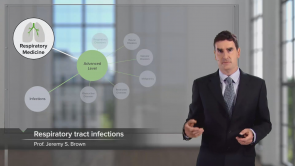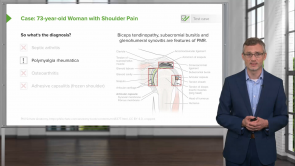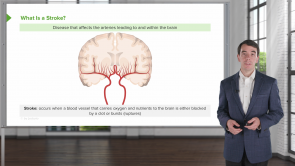Stroke: Pathophysiology

Über den Vortrag
Der Vortrag „Stroke: Pathophysiology“ von Roy Strowd, MD ist Bestandteil des Kurses „Year 2 – Neurology-Psychiatry“.
Quiz zum Vortrag
What is the normal rate of cerebral blood flow?
- Normal CBF is > 50 ml per 100 g brain tissue per minute.
- Normal CBF is > 10 ml per 100 g brain tissue per minute.
- Normal CBF is > 30 ml per 100 g brain tissue per minute.
- Normal CBF is > 75 ml per 100 g brain tissue per minute.
- Normal CBF is > 100 ml per 100 g brain tissue per minute.
What is described by the term "penumbral tissue?"
- An area of ischemic tissue surrounding the tissue affected by a stroke that is still potentially salvageable
- An area of normally perfused brain tissue
- An area of non-functioning brain tissue that has suffered infarction due to a stroke
- An area of the brain that has previously been affected by a stroke
- An area of brain tissue that has not been affected by a recent stroke
What is a very serious complication due to brain edema and mass effect after a stroke?
- Brain herniation
- Sodium/potassium channel dysfunction
- Penumbral tissue transformation
- Venous sinus thrombosis
- Thalamic infarction
How long after a stroke is the greatest risk of hemorrhagic transformation due to reperfusion?
- Hours to days after the event
- Days to weeks after the event
- Weeks to months after the event
- Months to years after the event
- Seconds to minutes after the event
What is meant by the phrase "time is brain?"
- Acute intervention during a time of cerebral ischemia can prevent a brain infarction and its associated clinical manifestations.
- Acute intervention after a brain infarction can prevent the extension of the stroke.
- Prevention of a stroke by risk factor modification saves brain tissue.
- Acute intervention after a brain infarction can prevent hemorrhagic transformation.
- Human brain tissue is rapidly and irretrievably lost as a stroke progresses and therapeutic intervention cannot prevent deterioration.
After acute occlusion of a cerebral blood vessel, what is the next step in the cascade of events?
- Sodium/potassium channels in the cells become dysfunctional
- Water influx into brain cells causes edema
- Brain swelling is seen on CT or MRI imaging
- Blood vessels become dysfunctional causing vasogenic edema and apoptosis
- Infarction and necrosis of brain tissue result
Diese Kurse könnten Sie interessieren
Kundenrezensionen
5,0 von 5 Sternen
| 5 Sterne |
|
1 |
| 4 Sterne |
|
0 |
| 3 Sterne |
|
0 |
| 2 Sterne |
|
0 |
| 1 Stern |
|
0 |
I loved how he took his time breaking the pathophysiology of the ischemic stroke in a way that I don't need to look up any terminology to understand him better







